Brachyponera obscurans
| Brachyponera obscurans | |
|---|---|

| |
| Scientific classification | |
| Kingdom: | Animalia |
| Phylum: | Arthropoda |
| Class: | Insecta |
| Order: | Hymenoptera |
| Family: | Formicidae |
| Subfamily: | Ponerinae |
| Tribe: | Ponerini |
| Genus: | Brachyponera |
| Species: | B. obscurans |
| Binomial name | |
| Brachyponera obscurans (Walker, 1859) | |
A nest of B. obscurans from a secondary forest in Macau contained about 400 individuals. The nest was covered by abundant rotten wood-litter and leaf-litter in an area with very moist soil. This ant nest was adjacent to a termite colony (Macrotermes barneyi) found nesting in wood laying on the ground surface. (Leong 2017)
| At a Glance | • Limited invasive |
Identification
Keys including this Species
Distribution
Latitudinal Distribution Pattern
Latitudinal Range: 30.75° to -19.01543334°.
| North Temperate |
North Subtropical |
Tropical | South Subtropical |
South Temperate |
- Source: AntMaps
Distribution based on Regional Taxon Lists
Indo-Australian Region: Borneo, Indonesia, Malaysia, New Guinea, Philippines, Singapore.
Malagasy Region: Mauritius.
Oriental Region: India, Sri Lanka (type locality).
Palaearctic Region: China.
Distribution based on AntMaps
Distribution based on AntWeb specimens
Check data from AntWeb
Countries Occupied
| Number of countries occupied by this species based on AntWiki Regional Taxon Lists. In general, fewer countries occupied indicates a narrower range, while more countries indicates a more widespread species. |

|
Estimated Abundance
| Relative abundance based on number of AntMaps records per species (this species within the purple bar). Fewer records (to the left) indicates a less abundant/encountered species while more records (to the right) indicates more abundant/encountered species. |

|
Biology
- Mean colony size: 400, n=1 (Leong, 2017)
- Nest site: litter (Leong, 2017)
Castes
Worker
 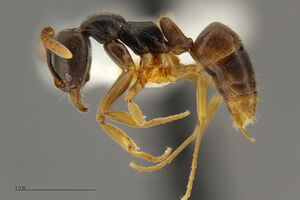 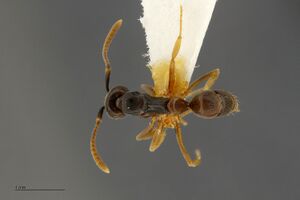 
| |
| . | Owned by Museum of Comparative Zoology. |
Queen
Images from AntWeb
 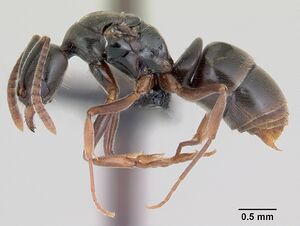 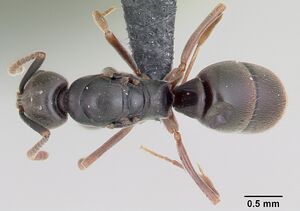 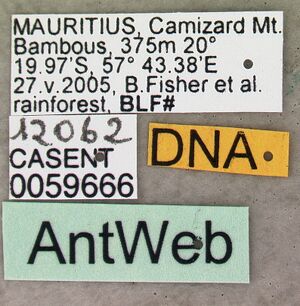
| |
| Queen (alate/dealate). Specimen code casent0059666. Photographer April Nobile, uploaded by California Academy of Sciences. | Owned by CAS, San Francisco, CA, USA. |
Nomenclature
The following information is derived from Barry Bolton's Online Catalogue of the Ants of the World.
- obscurans. Formica obscurans Walker, 1859: 372 (q.) SRI LANKA.
- Type-material: holotype queen.
- [Note: number of specimens as cited by Donisthorpe, 1932b: 575.]
- Type-locality: Sri Lanka (“Ceylon”): (no further data) (F. Walker).
- Type-depository: BMNH.
- Combination in Tapinoma?: Motschoulsky, 1863: 14;
- combination in Ponera: Donisthorpe, 1932b: 575;
- combination in Pachycondyla: Brown, in Bolton, 1995b: 308;
- combination in Brachyponera: Schmidt, C.A. & Shattuck, 2014: 80.
- Status as species: Mayr, 1863: 418; Smith, F. 1871a: 309; Dalla Torre, 1893: 202; Donisthorpe, 1932b: 575; Chapman & Capco, 1951: 200; Bolton, 1995b: 308; Pfeiffer, et al. 2011: 57; Guénard & Dunn, 2012: 61; Bharti, Guénard, et al. 2016: 49; Dias, R.K.S. et al. 2020: 105; Wang, W.Y., Soh, et al. 2022: 116.
- Distribution: China, India, Malaysia (Sabah), Singapore, Sri Lanka.
Description
References
- Brown, W. L., Jr. 1995a. [Untitled. Taxonomic changes in Pachycondyla attributed to Brown.] Pp. 302-311 in: Bolton, B. A new general catalogue of the ants of the world. Cambridge, Mass.: Harvard University Press, 504 pp. (page 308, Combination in Pachycondyla)
- Donisthorpe, H. 1932b. On the identity of some ants from Ceylon described by F. Walker. Ann. Mag. Nat. Hist. 10(9): 574-576 (page 575, Combination in Ponera)
- Esteves, F.A., Fisher, B.L. 2021. Corrieopone nouragues gen. nov., sp. nov., a new Ponerinae from French Guiana (Hymenoptera, Formicidae). ZooKeys 1074, 83–173 (doi:10.3897/zookeys.1074.75551).
- General, D.E.M. 2021. A preliminary checklist of the ants (Hymenoptera: Formicidae) of the Mt. Pantaron Range, Bukidnon Province, Mindanao Island, Philippines. Halteres, 12:4-14 (doi:10.5281/ZENODO.5371745).
- General, D.E.M., Buenavente, P.A.C., Rodriguez, L.J.V. 2020. A preliminary survey of nocturnal ants, with novel modifications for collecting nocturnal arboreal ants. Halteres 11: 1-12 (doi:10.5281/ZENODO.3707151).
- Leong, C. M. 2017. Biological notes on the colony of Brachyponera obscurans (Hymenoptera: Formicidae) in Macau. Taiwanese Journal of Entomological Studies. 2(1):10-12.
- Mamet, R. 1954. The ants (Hymenoptera Formicidae) of the Mascarene Islands. Mauritius Inst. Bull. 3: 249-259 (see also)
- Schmidt, C.A. & Shattuck, S.O. 2014. The higher classification of the ant subfamily Ponerinae (Hymenoptera: Formicidae), with a review of ponerine ecology and behavior. Zootaxa 3817, 1–242 (doi:10.11646/zootaxa.3817.1.1).
- Tawatao, N., Harper, N.E., Mohamed, M., Khenk, C.V., Searle, J.B. & Hill, J.K. 2011. Impacts of forest fragmentation on the genetic diversity and population structure of Pachycondyla obscurans in Sabah, Malaysian Borneo. Asian Myrmecology 4, 59–68.
- Walker, F. 1859. Characters of some apparently undescribed Ceylon insects. [part]. Ann. Mag. Nat. Hist. 3(4): 370-376 (page 372, queen
- Wang, W.Y., Soh, E.J.Y., Yong, G.W.J., Wong, M.K.L., Benoit Guénard, Economo, E.P., Yamane, S. 2022. Remarkable diversity in a little red dot: a comprehensive checklist of known ant species in Singapore (Hymenoptera: Formicidae) with notes on ecology and taxonomy. Asian Myrmecology 15: e015006 (doi:10.20362/am.015006).
- Yamane, S., Tanaka, H.O., Hasimoto, Y., Ohashi, M., Meleng, P., Itioka, T. 2021. A list of ants from Lambir Hills National Park and its vicinity, with their biological information: Part II. Subfamilies Leptanillinae, Proceratiinae, Amblyoponinae, Ponerinae, Dorylinae, Dolichoderinae, Ectatomminae and Formicinae. Contributions from the Biological Laboratory, Kyoto University 31, 87–157.
References based on Global Ant Biodiversity Informatics
- Chapman, J. W., and Capco, S. R. 1951. Check list of the ants (Hymenoptera: Formicidae) of Asia. Monogr. Inst. Sci. Technol. Manila 1: 1-327
- Dias R. K. S. 2002. Current knowledge on ants of Sri Lanka. ANeT Newsletter 4: 17- 21.
- Guénard B., and R. R. Dunn. 2012. A checklist of the ants of China. Zootaxa 3558: 1-77.
- Imai H. T., C. Baroni Urbani, M. Kubota, G. P. Sharma, M. H. Narasimhanna, B. C. Das, A. K. Sharma, A. Sharma, G. B. Deodikar, V. G. Vaidya, and M. R. Rajasekarasetty. 1984. Karyological survey of Indian ants. Japanese Journal of Genetics 59: 1-32.
- Leong C. M., S. F. Shiao, and B. Guenard. 2017. Ants in the city, a preliminary checklist of Formicidae (Hymenoptera) in Macau, one of the most heavily urbanized regions of the world. Asian Myrmecology 9: e009014.
- Li Z.h. 2006. List of Chinese Insects. Volume 4. Sun Yat-sen University Press
- Pfeiffer M.; Mezger, D.; Hosoishi, S.; Bakhtiar, E. Y.; Kohout, R. J. 2011. The Formicidae of Borneo (Insecta: Hymenoptera): a preliminary species list. Asian Myrmecology 4:9-58
- Sagata, K., A.L. Mack, D.D. Wright and P.J. Lester. 2010. The influence of nest avaiability on the abundance and diversity of twig-dwelling ants in a Papua New Guinea forest. Insectes Sociaux 57:333-341
- Tawatao N., N. E. Harper, M. Mohamed, C. V. Khen, J. B. Searle, and J. K. Hill. 2011. Impacts of forest fragmentation on the genetic diversity and population structure of Pachycondyla obscurans in Sabah, Malaysian Borneo. Asian Myrmecology 4:59-68.

